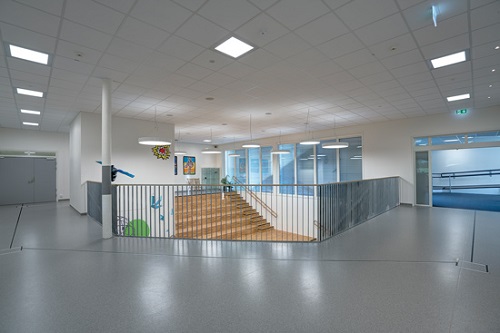








The new Holla comprehensive school near Telemark, Norway opened for the 2016 school year with LED-based lighting inside and out, including tunable-white lighting in class and group rooms. The tunable lighting is considered human-centric lighting (HCL) or what is sometimes referred to as lighting for health and wellbeing. The spectrum can be set to boost alertness at times, for instance, during an exam, or for a relaxed environment at other times. The school hopes the system will improve learning and also help students sleep better at night. The solid-state lighting (SSL) project further included other standard LED fixtures with fixed spectrum indoors and out.
Interested in articles & announcements on tunable LED lighting in human-centric lighting applications?
Glamox Luxo Lighting supplied the lighting products for the school. The company specializes in lighting products for schools, healthcare facilities, retail, hospitality, and commercial and industrial buildings. HCL capabilities are offered in a number of Glamox luminaires. The company relies on the DALI (digital addressable lighting interface) platform for control and supports control components and systems from a number of third parties such as Tridonic and Helvar.
Tunable luminaires
The C90-R family of luminaires used in the Holla teaching rooms have the HCL capability (Fig. 1). The recessed 2×2-ft, troffer-style fixtures have a planar optic that delivers uniform light across the surface. The HCL version of the fixture can produce light across the spectrum of 2500K CCT to 7000K CCT - from warmer than incandescent lamps to a very cool color temperature. The luminaire design closely tracks the black-body locus across that range. The luminaires also deliver excellent color rendering with CRI above 90. And the school feels that such high CRI will further enhance the learning experience.
Given the control system involved, a teacher or school administrator could potentially set the CCT and dim level of the installed lighting to any desired configuration. Lumen output ranges to 4616 lm. But the installation has been customized to enable simple adjustments of the lighting for the typical modes that might come into play on a daily basis.
The Standard setting for most activities configures the lighting to 3500K. Teachers have a DALI panel in each room to turn lights on or off and to adjust the dim level. The Standard setting is designed to deliver horizontal illuminance of 300 lx on a plane 0.75m above the floor - desk level.
Energy and focus
The system also includes Energy and Focus settings. First, let's discuss the photometric characteristics, which are the same for both settings, and then we will consider the different ways in which the two settings are applied.
The lighting design took into account the concept called cylindrical illuminance and often abbreviated Ez. The Ez metric is a value in lux that represents the mean value of vertical illuminance on a cylinder. Requirements for cylindrical illuminance have been defined in the European standard EN 12464-1:2011 for indoor workplace lighting, and for sitting workers that calculation is based on a height of 1.2m from the floor - typical head height. The school system delivers Ez of 350 lx at 1.2m and a CCT of 6500K in the Energy or Focus modes.
The Energy setting is managed by the building management systems (BMS) to which all of the SSL products are linked. The BMS enables the Energy setting automatically for the first lesson of the day in each classroom. The intent is to adjust the circadian rhythm of the students first thing in the morning.
The installation of the system was in part based on work done at the Norwegian Competence Center for Sleep Disorders at Haukeland University Hospital. University researcher Ingvild West Saxvig said, "During puberty, the sleep pattern often shifts towards later bedtime and awakening. This may reduce the performance among adolescents and adults."
The HCL implementation is intended to help prevent delayed sleep-wake cycles among the students. The cool to cold lighting presumably pushes the circadian rhythm forward to improve alertness and also makes the students sleepy at the appropriate time at night.
Copyright 2006-2025 Shanghai Sinoexpo Informa Markets International Exhibition Co., Ltd. All rights reserved